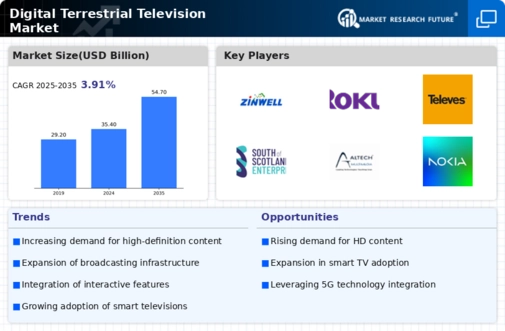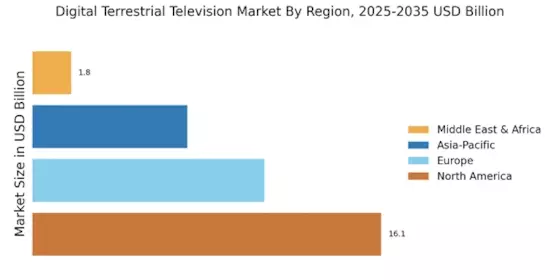Regulatory Support
Regulatory frameworks play a pivotal role in shaping the Digital Terrestrial Television Market. Governments are increasingly recognizing the importance of digital broadcasting and are implementing policies that support its growth. For instance, many countries have established mandates for transitioning from analog to digital broadcasting, which has led to a significant increase in digital television penetration. As of October 2025, regulatory bodies in various regions have reported that digital television adoption has reached approximately 95%, underscoring the effectiveness of these policies. This supportive regulatory environment not only fosters investment in infrastructure but also encourages innovation within the Digital Terrestrial Television Market, ultimately benefiting consumers.
Technological Advancements
The Digital Terrestrial Television Market is experiencing a surge in technological advancements that enhance viewer experience. Innovations such as improved compression techniques and advanced transmission standards, like DVB-T2, are becoming increasingly prevalent. These technologies allow for higher quality broadcasts and more efficient use of bandwidth, which is crucial as the demand for high-definition content rises. As of October 2025, it is estimated that over 80% of households in certain regions have access to high-definition broadcasts, indicating a shift in consumer expectations. This trend suggests that the Digital Terrestrial Television Market must continuously adapt to incorporate these advancements to remain competitive and meet the evolving needs of viewers.
Integration of Smart Technologies
The integration of smart technologies into the Digital Terrestrial Television Market is transforming how consumers interact with television content. Features such as on-demand viewing, personalized recommendations, and interactive applications are becoming standard expectations among viewers. As of October 2025, it is estimated that nearly 50% of households utilize smart TVs or devices that support these functionalities. This shift indicates a growing trend towards a more interactive viewing experience, compelling broadcasters to innovate and adapt their offerings. The Digital Terrestrial Television Market must embrace these technologies to remain relevant and meet the demands of a tech-savvy audience.
Consumer Demand for Diverse Content
The Digital Terrestrial Television Market is witnessing a notable shift in consumer demand for diverse and localized content. Viewers are increasingly seeking programming that reflects their cultural preferences and interests, which has prompted broadcasters to expand their offerings. As of October 2025, data indicates that over 60% of viewers express a preference for local content, leading to a rise in regional channels and specialized programming. This trend suggests that the Digital Terrestrial Television Market must prioritize content diversity to attract and retain audiences. By catering to these preferences, broadcasters can enhance viewer engagement and loyalty, ultimately driving growth in the market.
Increased Competition from Streaming Services
The Digital Terrestrial Television Market faces heightened competition from streaming services, which are rapidly gaining popularity among consumers. As of October 2025, streaming platforms account for a significant portion of viewership, with many households opting for subscription-based models over traditional broadcasting. This shift in consumer behavior poses challenges for the Digital Terrestrial Television Market, as it must find ways to differentiate itself and retain viewers. Strategies such as offering exclusive content, bundling services, and enhancing viewer experience are essential for competing with the allure of streaming services. The industry must adapt to this competitive landscape to sustain its relevance and growth.


















Leave a Comment